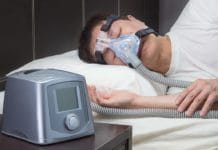Much discussion has been devoted to vaping during the last few months after several reported deaths and hundreds with related lung disease illnesses around the United States. As dental hygiene clinicians on the front lines in health care, we need to be aware of this in order to help educate our patients with accurate information that could potentially help save their lives.
What is Vaping?
Inhaling and exhaling nicotine-containing fluid as an aerosol, referred to as a vapor. The vapors are inhaled into the mouth and lungs, entering the circulatory system. This isn’t a new invention. The first documented reference to an e-cigarette dates to 1930 when Joseph Robinson was awarded a patent for a device never sold on the market. In 1965, Herbert Gilbert was issued a patent for his e-cig prototype.
They were introduced to Europe and the United States in 2006-2007. Typically, e-cigs all consist of a mouthpiece, cartridge, heating component, and a charger. They are called by several names such as vape pens and mods. The e-juice cartridges consist of nicotine, propylene glycol, glycerin, flavoring, volatile organic compounds, diacetyl, and heavy metals. These are not regulated, and the nicotine content among different manufacturers such as Juul, Fogg, Kilo, and Mojo can vary from .03% – 7.2% by volume. Many users do not know that the level of nicotine in one Juul pod contains the equivalent of the nicotine in 20 cigarettes.
Which of Your Patients are Vaping?
According to FDA statistics in 2018, more than 3.6 million middle and high school students were current e-cigarette users. That was an increase of 1.5 million minors since 2017. Plenty of adult vapers are using as well; some are vaping to try and stop smoking traditional cigarettes as it can be done in smoke-free areas of work, restaurants, or entertainment establishments.
The legal age in the United States for purchasing vaping pens or cartridges ranges from 18 to 21 years depending on the state. With this knowledge, any patient from age 11-99 could be a vape user. I am sure that many of us are having the discussion with patients about tobacco use and smoking cessation, and I would urge you to now begin the conversations about e-cigarettes, vaping, and the health risks they pose.
What Happens When Someone is Vaping?
Long-term studies about the impact and health effects of vaping are still being researched. Early studies show, though, that pulmonary toxicity may occur, and metal nanoparticles can deposit in the lungs from use. E-cigs contain toxic chemicals that have been linked to cancer, as well as respiratory and heart diseases.
Glycerin, when inhaled, causes irritation of the airways and excessive bowel activity. Diacetyl vapors are very dangerous. It is known to destroy lung tissue and bronchioles, causing popcorn lung and other pulmonary complications.
Oral implications include inflammation of the gingiva and potential for delayed healing, xerostomia due to the propylene glycol content with the increased potential for caries. There is also periodontal breakdown of ligaments, bone, and eventual tooth loss. Remember the potential oral health effects of the e-cig vapors are still largely unknown.
The FDA has in recent weeks, placed restrictions on sales to anyone under the age of 18 for vaping implements, certain marketing, and sales practices. For example, the popular and animated characters and flavors mainly targeted at youth have been stopped. Nicotine addictiveness warnings on packages and advertising will now be required. Hopefully, these steps will help to curb the numbers of persons with access to e-cigs and by spreading the word with our patients we can help to educate them on the serious life-threatening consequences of vaping.
Now Listen to the Today’s RDH Dental Hygiene Podcast Below:
References
- A Historical Timeline of Electronic Cigarettes. Consumer Advocates for Smoke Free Alternatives Association. Retrieved from http://www.casaa.org/historical-timeline-of-electronic-cigarettes/
- Know the Risks: E-Cigarettes and Young People. Surgeon General Advisory. Retrieved from https://e-cigarettes.surgeongeneral.gov/
- Expert Views: E-Cigarettes. Center on Addiction. Retrieved from https://www.centeronaddiction.org/e-cigarettes
- Supporting Regulation of Electronic Nicotine Delivery Systems: Policy number: 20186. American Public Health Association. Nov 13 2018. Retrieved from https://apha.org/policies-and-advocacy/public-health-policy-statements/policy-database/2019/01/28/supporting-regulation-of-electronic-nicotine-delivery-systems












